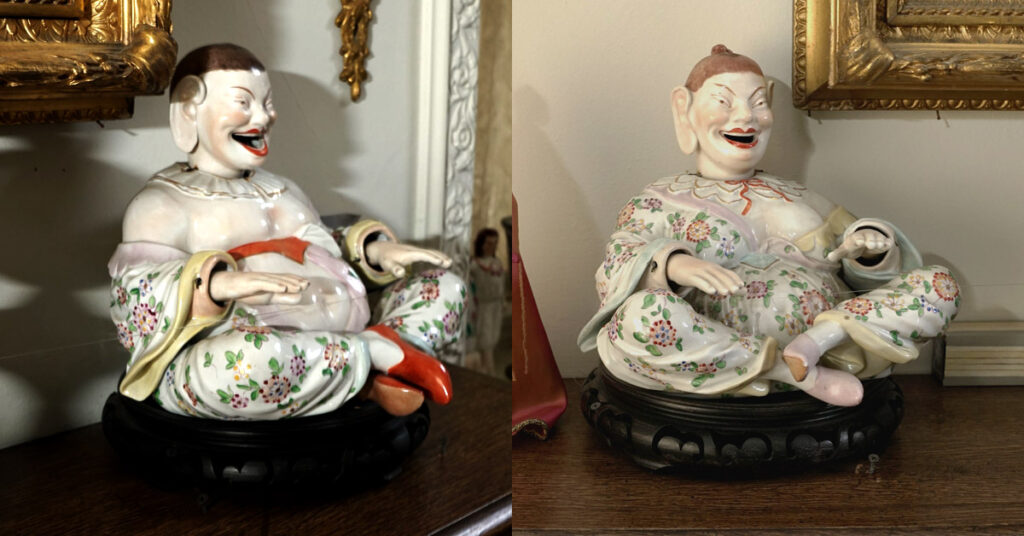 A plump grotesque porcelain figure in the Asian style, the head nods, hands bob up and down, tongue lolls in the smiling mouth. We call this a nodding magot, a late 17th century term for such seated ‘oriental’ figures. Many of these figures were modeled after the smiling Chinese god of happiness and abundance, Pu tai. Two such figures gave the Parisian café,, the famed ‘Les Deux Magots,’ its name. As this café displays a pair of these figures on a bracket mounted on the wall.
A plump grotesque porcelain figure in the Asian style, the head nods, hands bob up and down, tongue lolls in the smiling mouth. We call this a nodding magot, a late 17th century term for such seated ‘oriental’ figures. Many of these figures were modeled after the smiling Chinese god of happiness and abundance, Pu tai. Two such figures gave the Parisian café,, the famed ‘Les Deux Magots,’ its name. As this café displays a pair of these figures on a bracket mounted on the wall.
WG owns a pair representing the late 17th, early 18th century taste for the exotic, a great wave of a fad that swept over Europe called chinoiserie. WG’s “noddy” magots are a great example of this style. Other examples include 18th and 19th century European crafted furniture decorated in Asian themed scenes in lacquerware.
Nodding Magots: Engineering Works of Art
These nodding figures were engineering works of art as well as highly collectible objects in the 18th century. Nodding head and neck came as separate pieces of the figure. They mounted the head to a lead filled weight, the hands similarly balanced as separate inserts hung with weights inside the cuffs. Aristocratic people displayed these status symbols in their homes. Superstition arose about their good luck, as they predicted earthquakes!
Chinese porcelain artists exported the first nodding magots through trade with Venetian dealers in the late 17th century. Dutch ships to China didn’t keep up with the demand for these novelties so European porcelain houses imitated these strange figures. The 18th century figures produced by Meissen became the most famous magots. But other German porcelain houses copied these as well, such as Dresden and Rudolstadt. French porcelain houses caught on and produced magots by Saint Claude, Samson, and Chantilly. Northern Italians picked up the design and Piedmontese craftsman produced them in papier-mâché. It seems odd that figures so grotesque met such demand!
Man of letters and philosopher Denis Diderot (1713-1784) said of this craze, “These precious knick knacks with which the country has become infatuated have banished more tasteful ornaments from our apartments. The reign of Louis XV is the reign of magots.” He also gave a section in his Encyclopedie to magot figures. His Encyclopedie became one of the principal works of the Age of Enlightenment.
Imported Chinese and Japanese silks of the early 18th century inspired fat bellies decorated with floral motif robes. Ornately patterned Indian cotton fabrics arrived via the East India Companies as well. WG’s noddy magots, were made of soft paste porcelain with polychrome enamel decoration.
Expensive Noddy Magots
A noddy headed figure created in precious stones by Carl Faberge for Tzar Nicholas II, the last Emperor of Russia, in 1900 sold recently. This seated nodding magot with moveable hands carved in precious bowenite, set with rubies, diamonds, pearls, and enamel. Faberge visited Dresden and saw the Meissen porcelain magot. He fell in love with the idea of creating a carved precious stone magot set with diamonds and rubies. Faberge’s magot even came with a lolling movable tongue made of a carved ruby.
China exported a pair of standing nodding magots, both female ladies of the Chinese court, in the 18th century. This pair formerly belonged to the late Senator Dianne Feinstein. Bonham’s Auctions in Los Angeles offered them as part of the “Legacy of a Stateswoman” for $4,000-$6,000.
WG asked I write about her pair of magots, dear to her as descended from her father. Hers are late 18th century German porcelain pieces. Both have the elongated earlobes associated with good fortune. Although these aren’t popular in the market today due to a change of taste and inevitable discernment of political correctness. Fifty years ago they were worth $1,500 each. Today I place the value at $1500 if in perfect condition. The pair are a great example of changes in what is considered ‘exotic;’ once 18th century status symbols only displayed in the best homes, a difficult sell today.